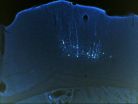Negative news stories affect women's stress levels but not men's
Researchers find that the media can change women's sensitivity to stressful situations
2012-10-11
(Press-News.org) Bad news articles in the media increase women's sensitivity to stressful situations, but do not have a similar effect on men, according to a study undertaken by University of Montreal researchers at the Centre for Studies on Human Stress of Louis-H. Lafontaine Hospital. The findings were published today in PLOS One. The women who participated in the study also had a clearer recollection of the information they had learned. "It's difficult to avoid the news, considering the multitude of news sources out there, said lead author Marie-France Marin. "And what if all that news was bad for us? It certainly looks like that could be the case."
The researchers asked 60 people divided into four groups to read actual news stories. In order to determine their stress levels, the researchers took samples of the participants' saliva and analyzed them for a hormone called cortisol. Higher levels of this bodily chemical indicate higher levels of stress. A group of men and a group of women read "neutral" news stories, about subjects such as the opening of a new park or the premiere of a new film, while the another two gender segregated groups read negative stories, about events such as murders or accidents. Saliva samples were taken again in order to determine the effect of these news stories. "When our brain perceives a threatening situation, our bodies begin to produce stress hormones that enter the brain and may modulate memories of stressful or negative events," explained Sonia Lupien, Director of the Centre for Studies on Human Stress and a professor at the university's Department of Psychiatry. "This led us to believe that reading a negative news story should provoke the reader's stress reaction."
The participants were then confronted with a series of standardized tasks involving memory and intellect that enable researchers to evaluate and compare how people react to stressful situations. A final round of samples was then taken to determine the effects of this experience. Finally, the next day, the participants were called back to talk about what they had read. The researchers were surprised by what they found. "Although the news stories alone did not increase stress levels, they did make the women more reactive, affecting their physiological responses to later stressful situations," Marin explained. The researchers discovered this when they saw that the level of cortisol in the women who have read the negative news was higher after the "stress" part of the experiment compared to the women who have read the neutral news. "Moreover, the women were able to remember more of the details of the negative stories. It is interesting to note that we did not observe this phenomenon amongst the male participants."
The researchers believe that evolutionary factors may be at play, noting that other scientists have considered whether an emphasis on the survival of offspring may have influenced the evolution of the female stress system, leading women to be more empathetic. This theory would explain why women could be more susceptible to indirect threats. "More studies should be undertaken to better understand how gender, generational differences and other socio-cultural factors affect our experience, as individuals, of the negative information that perpetually surrounds us," Marin said.
INFORMATION:
Notes
The study "There is no news like bad news: Women are more remembering and stress reactive after reading real negative news than men" was published on October 10, 2012, in PLOS One. The research was funded in part by the Canadian Institutes of Health Research (CIHR) Chair on Sex, Gender and Mental Health. The University of Montreal is known officially as Université de Montréal.
Sonia Lupien is the Scientific Director of the Fernand-Seguin Research Centre at Louis-H. Lafontaine Hospital and a professor at the University of Montreal's Department of Psychiatry. She is the founder and director of the Centre for Studies on Human Stress and she holds the Canadian Institutes of Health Research Chair on Sex, Gender and Mental Health.
Marie-France Marin is affiliated with the Fernand-Seguin Research Centre at Louis-H. Lafontaine Hospital, Centre for Studies on Human Stress, and the University of Montreal's Department of Psychiatry. She is currently in Boston.
END
ELSE PRESS RELEASES FROM THIS DATE:
2012-10-11
The remarkably well-preserved fossil of an extinct arthropod shows that anatomically complex brains evolved earlier than previously thought and have changed little over the course of evolution. According to University of Arizona neurobiologist Nicholas Strausfeld, who co-authored the study describing the specimen, the fossil is the earliest known to show a brain.
The discovery will be published in the Oct. 11 issue of the journal Nature.
Embedded in mudstones deposited during the Cambrian period 520 million years ago in what today is the Yunnan Province in China, the ...
2012-10-11
Researchers have published the first highly detailed description of how neurotensin, a neuropeptide hormone which modulates nerve cell activity in the brain, interacts with its receptor. Their results suggest that neuropeptide hormones use a novel binding mechanism to activate a class of receptors called G-protein coupled receptors (GPCRs).
"The knowledge of how the peptide binds to its receptor should help scientists design better drugs," said Dr. Reinhard Grisshammer, a scientist at the NIH's National Institute of Neurological Disorders and Stroke (NINDS) and an ...
2012-10-11
The well-documented presence of excessive levels of carbon dioxide (CO2) in our atmosphere is causing global temperatures to rise and glaciers and ice caps to melt.
New research, published today, 11 October, in IOP Publishing's Journal of Physics D: Applied Physics, has shown that CO2 molecules may be having a more direct impact on the ice that covers our planet.
Researchers from the Massachusetts Institute for Technology have shown that the material strength and fracture toughness of ice are decreased significantly under increasing concentrations of CO2 molecules, ...
2012-10-11
Who we call and how long we speak to them changes with the weather, according to new research by experts at Newcastle University.
Analysing the call patterns of 1.3 million mobile phone users, the team found that in 'uncomfortable' weather – such as very hot, humid, wet or cold weather – call length increased but the number of people we made contact with went down.
Apparently "isolating" ourselves during more unpleasant weather, research lead Dr Santi Phithakkitnukoon said the data showed that we were also more likely to contact our close friends and family than our wider ...
2012-10-11
A team using the Atacama Large Millimeter/submillimeter Array (ALMA), the most powerful millimetre/submillimetre telescope in the world, has discovered a surprising spiral structure in the gas around the red giant star R Sculptoris [1][2][3]. This means that there is probably a previously unseen companion star orbiting the star [4]. The astronomers were also surprised to find that far more material than expected had been ejected by the red giant.
"We've seen shells around this kind of star before, but this is the first time we've ever seen a spiral of material coming ...
2012-10-11
DURHAM, N.C. -- Guys who imitate Luciano Pavarotti or Justin Bieber to get the girls aren't alone. Male mice may do a similar trick, matching the pitch of other males' ultrasonic serenades. The mice also have certain brain features, somewhat similar to humans and song-learning birds, which they may use to change their sounds, according to a new study.
"We are claiming that mice have limited versions of the brain and behavior traits for vocal learning that are found in humans for learning speech and in birds for learning song," said Duke neurobiologist Erich Jarvis, who ...
2012-10-11
PHOENIX, Ariz. — Oct. 10, 2012 — Whole genome sequencing — spelling out all 3 billion letters in the human genome — "is an obvious and powerful method for advancing our understanding of pancreatic cancer," according to a new study from TGen, Mayo Clinic and Scottsdale Healthcare published today.
The Translational Genomics Research Institute (TGen) demonstrated that the use of WGS "represents a compelling solution to obtaining detailed molecular information on tumor biopsies in order to provide guidance for therapeutic selection," concluded the study published by the journal ...
2012-10-11
PORTLAND, Ore. – Physician-scientists at Oregon Health & Science University Doernbecher Children's Hospital have demonstrated for the first time that banked human neural stem cells — HuCNS-SCs, a proprietary product of StemCells Inc. — can survive and make functional myelin in mice with severe symptoms of myelin loss. Myelin is the critical fatty insulation, or sheath, surrounding new nerve fibers and is essential for normal brain function.
This is a very important finding in terms of advancing stem cell therapy to patients, the investigators report, because in most ...
2012-10-11
Writing in Nature, Nobel Prize-winner Professor Kostya Novoselov and an international team of authors has produced a 'Graphene Roadmap' which for the first time sets out what the world's thinnest, strongest and most conductive material can truly achieve.
The paper details how graphene, isolated for the first time at The University of Manchester by Professor Novoselov and colleague Professor Andre Geim in 2004, has the potential to revolutionise diverse applications from smartphones and ultrafast broadband to anticancer drugs and computer chips.
One key area is touchscreen ...
2012-10-11
A workshop sponsored by NIH's National Institute of Neurological Disorders and Stroke (NINDS) has produced a set of consensus recommendations to improve the design and reporting of animal studies. By making animal studies easier to replicate and interpret, the workshop recommendations are expected to help funnel promising therapies to patients.
Biomedical research involving animals has led to life-saving drugs for heart disease, cancer, stroke, diabetes, HIV-AIDS, and many other conditions, but positive results from animal studies are sometimes difficult to translate ...
LAST 30 PRESS RELEASES:
[Press-News.org] Negative news stories affect women's stress levels but not men's
Researchers find that the media can change women's sensitivity to stressful situations



